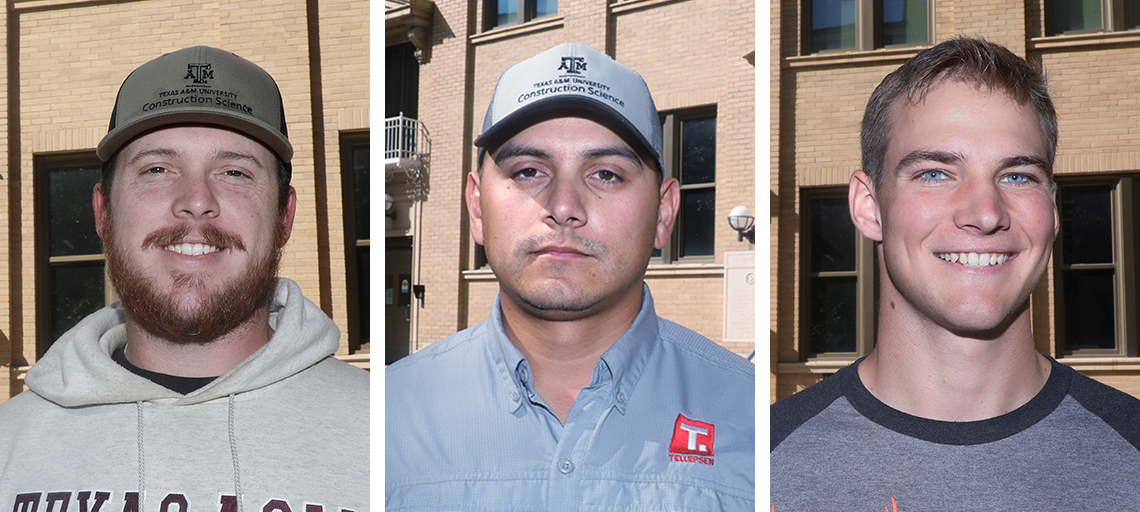Construction Science and Veterans: A Perfect Combination
Texas A&M University takes great pride in serving its military veterans, and its Texas A&M’s Veterans Resources office has numerous resources to serve veterans and their families. The university currently assists more than 3,800 students who have served or currently are serving in the U.S. military, and has helped veterans since 1919.
But perhaps nowhere is that pride more evident than its Department of Construction Science, where it sometimes has as many as 75 veterans out of its 1,300 or so students.
The reasons for the high veteran turnout vary, said Patrick C. Suermann, department head and associate professor, but developing relationships might be the No. 1 factor.
“We have a strong relationship with the Knauss Veterans’ Resource Support Center and its director, retired Col. Jerry Smith ’82, ” said Suermann. “They find that veterans want to help others, are great at leading teams, and have an advanced mind for logistics. These skills parlay well into a successful career in construction management. Word of mouth helps from there because construction science is one of the best programs at Texas A&M.”
Suermann added that Texas A&M construction science has a very strong internship program in which its students often impress their employers, he said.
“Student veterans usually make their mark immediately and employers rave about their ability to transition and integrate into leading disparate teams,” he said. “Also, students get paid and typically come back to campus debt free or with a new vehicle to prepare them for their role upon graduation. Our students make an average of over $67,000 upon graduation, and it’s even higher for veterans – they make upwards of $80,000 to $100,000 upon completion of their undergrad degree, especially if they work on international or security clearance-required projects abroad like consulates and embassies.”
First-hand knowledge
When it comes to knowing veterans, Suermann can apply his own experiences on a first-hand level.
He was an Air Force Academy cadet for four years and an Air Force civil engineer for 20 years. He traveled the world managing military construction projects in Saudi Arabia, Guam, the Pacific, Afghanistan and Greenland. He still does consulting work with NASA.
“But it all started with degrees at Texas A&M and the University of Florida,” he said. “If I was not doing construction, I was teaching construction engineering at the Air Force Academy.”
A reflection of the industry
Skylar Kitzmiller, who currently serves in the Army National Guard and was stationed in Washington, D.C. during the Capitol incident on Jan. 6, believes the construction science program is so popular among veterans because it is reflective of the industry itself.
“The construction industry tends to be pro-veteran and the department reflects that in the best way,” he said. “Also, with many faculty and students being veterans, there is a special understanding of the unique situations veteran students may encounter, and that attracts more military students to construction science than to other majors.
“I was attracted to the program even before I began my military career,” he added, “so that may set me aside from others. The program culture pushes students to reach beyond what they may have initially thought possible, and I found that aspect to be very attractive. In addition, the small size of the program fosters a sense of community that many service members appreciate, and the job placement rate after graduation cannot be beat. If a veteran is looking to attend a college program that will provide a positive college experience and then a great job after graduation, I would say that there is no better place to start your second career than in the construction science department.”
Attention to detail
Charles Barrington, a junior construction science major from North Zulch, served six years in the Air Force and was stationed in Japan and Idaho and worked on F-15 fighter jets. He said that like the military, the construction science program requires discipline and attention to detail.
“There is also the camaraderie that comes with this program really translates with veterans,” he said. “The program appealed to me because I have always been interested in construction and the fine details that come with putting a building together. I wanted to be a part of this process, but I wanted to be more hands-on in the field. I believe this program allows me to do that. Also, it allows me to take the training I gained from the Air Force and move it over into the construction industry.
“I would absolutely recommend this major to other veterans,” he added. “Veterans are used to some of the attributes that comes with this job like high stress, attention to detail, and management. Construction is a very important part of our economy so it’s important to have the right people doing the job. I believe veterans are the perfect people to fills these management positions.”
A campus destination for veterans
Erbey Hernandez, a senior construction science major from Odessa, said the high concentration of veterans appeals to those who may be considering joining the program. The leadership of the department coupled with its technical skills got his attention very quickly.
“The construction science program at Texas A&M is the largest and best construction science program in the nation,” he said. “They also offered an excellent job placement rate after graduation, which was essential for me. It would not have made sense for me to go to another program or major that would not be able to practically guarantee me a job after graduation.
“I would recommend this program to other veterans time and time again. The professors in this department are some of the best on the entire campus. I have formed great relationships with professors since my first semester, and I highly recommend this program to other veterans. There are many veteran professors in this program, including the department head, and they all make themselves available to offer help both in and out of class.”


